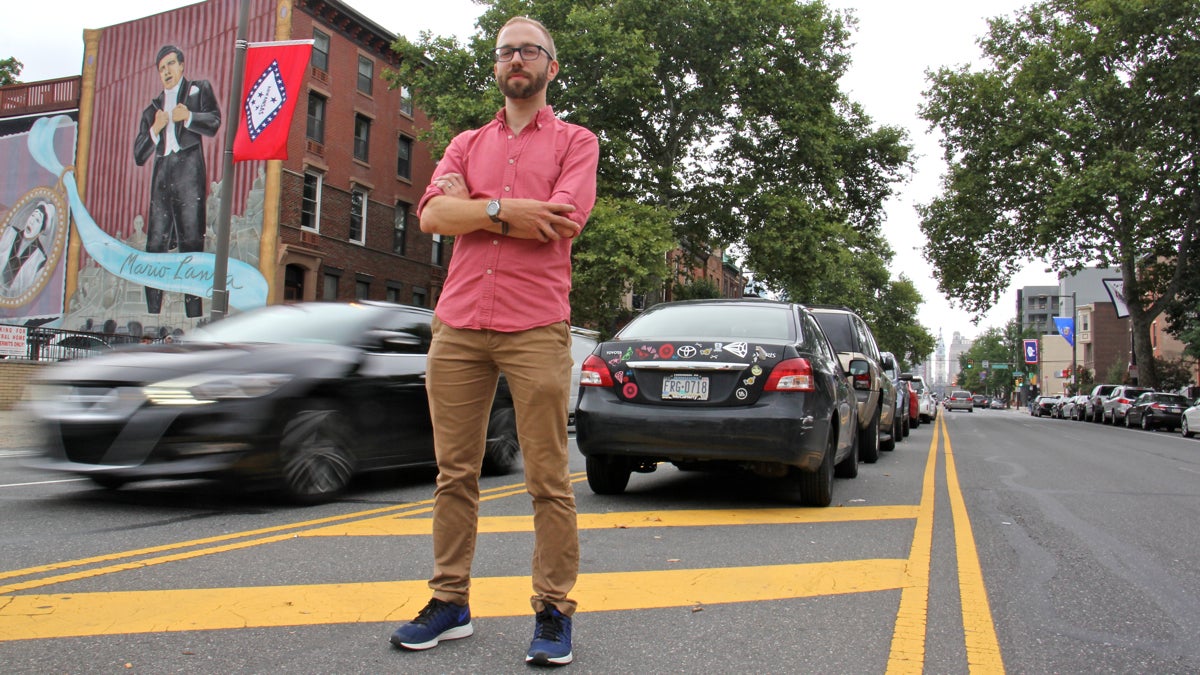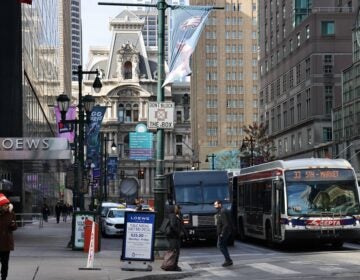South Philly rite all wrong, says group pushing to end median parking on Broad
Listen
Jake Liefer and his PAC
Walking his dog down South Broad, George Van Sciver said the subject comes up a lot when he’s hosting friends from other cities.
“Many out-of-towners say, ‘What on earth is this craziness with cars in the middle of Broad Street?’ And I say, ‘That’s South Philly.'”
Parking in the middle of South Broad is technically illegal, yet the Philadelphia Parking Authority and other city officials haven’t enforced the rule in decades.
Mike Messina, who has worked at a funeral home on South Broad for 45 years, likes the tradition.
“It’s part of South Philadelphia,” he said. “We park crazy down here.”
That’s where 31-year-old Jake Liefer steps in. He’s lived in South Philly for four years and works with a political action committee called 5th Square that’s focused on urban policy. The group thinks allowing the median of one of the busiest streets in the city to serve as a parking lot is a bad idea, and their petition is picking up traction.
“We see a lot of crashes occur, whether it’s a pedestrian that crosses and a car doesn’t see them because of a parked car,” Liefer said “Or because somebody’s opening a car door and there’s a 35 mph car going past.
“As far as an illegal practice, it doesn’t necessarily make it a practice just because it happens again and again.”
Messina from the funeral house responds that nobody would be able to find a parking space if the middle-of-the-road parking vanished.
“I mean, I don’t see a safety problem. There’s always goofballs who will try to make a U-turn anyway,” he said.
The parking was eliminated over the Democratic National Convention, and Liefer’s group argues that short time was proof that drivers are able to find other spots.
After dropping letters in a mailbox at Broad and Reed, longtime resident Anne Mattei recounted a different experience during the recent convention.
“For four days, I did not move my car because I was a afraid to lose that parking space. For four days, we were prisoners,” Mattei said. “They don’t understand.”
Debate spans a half century
The issue has been fiercely controversial for generations. In the summer of 1961, Mayor Richardson Dilworth proposed a South Philly parking plan that would have affected 24 blocks south of Washington Avenue. It required that motorists buy permits from the city for curbside parking. All other parking, including leaving cars in the median, would be illegal — and scofflaws would be towed away.
“The mayor has contended that South Philadelphia will become a ‘slum’ if parking congestion, which he says now threatens to stifle the area, is not relieved,” according to a 1961 story published in the Philadelphia Bulletin.
During a public meeting, Dilworth was greeted with thousands of angry residents who pelted him with rocks. An officer guarding the mayor was struck in the head with a glass milk bottle. One councilman said, the mayor “better get out of here before somebody gets killed,” wrote a reporter in 1961 in the Philadelphia Tribune, describing the scene as a “near riot.”
That night, guards kept watch over Dilworth’s Washington Square home for protection.
An anomaly and a tradition
Asked about scrapping the tradition in light of the petition, Mayor Jim Kenney basically said recently, if something does move forward, it’s not going to happen anytime soon.
“I know it’s an anomaly for many neighborhoods to see that,” Kenney said of the parking arrangement.
Kenney himself is a South Philly native who understands how deeply rooted those customs are among residents who have lived there for generations.
“Anything we do in that regard has to be done in conjunction with discussions with the community,” he said.
But even having community discussions is addressing the subject more than it has been since the 1960s, said Murray Dubin, former Inquirer reporter who wrote “South Philadelphia: Mummers, Memories, and the Melrose Diner.”
It’s just one of those hallowed customs that no mayor has been willing to meddle with, and Dubin expects it to stay that way despite growing concerns over safety.
“They feel like it’s almost a right that’s been grandfathered,” he said. “They feel like it doesn’t cost the city money. It’s something they need. And the sense is, ‘Why are you messing with my life?'”
The origin story does not have clear roots. But Dubin’s theory is that mourners started parking there sometime after World World II “because the funeral homes had nowhere to park for the people going to the funerals. And it just continued,” he said.
In a five-block radius, there are 20,000 parking spaces, according to Liefer with the urban policy PAC. The median parking on Broad creates just 200 more. Accidents happen less frequently north of Washington Avenue, he said, where middle-of-the-road parking is less common. Pedestrians and motorists tend to be safer without a string of parked cars hemming lines of traffic, he said.
More than 1,100 people have signed Liefer’s petition asking the mayor to kick all the cars out of the middle of the road.
One thing’s for sure: A guy who would only be identified as Sal isn’t feeling it. As he pulled his silver Hyundai into the median just south of Wharton, he said there’s not a snowball’s chance in hell that his name will appear on the petition. His gripe? Too many cars in South Philly.
“If it’s too congested in the parking spots, people will bang into your bumper and they try to squeeze in,” he said.
Long time out of the loop
Then there are residents such as Dennis O’Malley, who has lived in South Broad for 20 years. He takes a certain kind of comfort in the parking lot bisecting the street.
“If you crossed Broad Street in the middle of the block. You can wait between the cars for the traffic to go by,” O’Malley said. “You can’t get hit.”
North Philadelphia resident Ed Birkenheuer, who was walking along Broad, said he’s ready to put his name down.
“It’s too much,” Birkenheuer said. “You have traffic. You can’t get around people. You got people coming through the cars. You have to watch out for everything. You got kids coming through there.”
Author Dubin, who’s from South Philly and has long chronicled its traditions and lore, said the singularity of the area was established long ago.
Before the 1860s, Philadelphia’s boundaries ran from South Street to Vine, river to river.
“So, South Philly was not part of the city, it’s part of the county,” Dubin said.
“If you do the math, South Philadelphia has still been out of the city longer than it’s been in the city,” he said. “There certainly was a distrust of government … they felt like they had to fend for themselves, and for many people, they still feel that way.”
—
Correction: An earlier version of this story indicated that traffic accidents happen more frequently north of Washington Avenue than south. They happen less frequently north of Washington Avenue.
WHYY is your source for fact-based, in-depth journalism and information. As a nonprofit organization, we rely on financial support from readers like you. Please give today.




